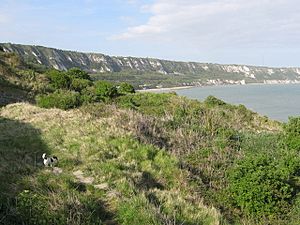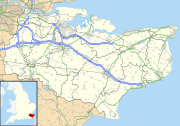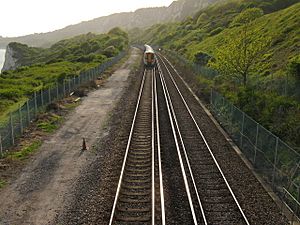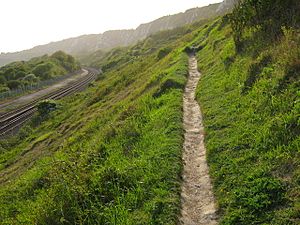East Cliff and Warren Country Park facts for kids
East Cliff and Warren Country Park is a special place in Folkestone, Kent, England. It's a country park made up of the tall East Cliffs, the sandy beaches of East Wear Bay, and a nature reserve. This reserve is on land that has slipped down between the cliffs and the sea over time.
History of the Park
On the East Cliffs, you can find three old Martello Towers. These towers were built between 1804 and 1809. Their purpose was to protect England from a possible invasion by Napoleon's French army.
Since 1990, Martello Tower Number 3 has been a visitor center. It is run by the Folkestone and Hythe Council. Next to it, there is a sign that tells you about the ruins of a Roman villa that used to be on this site.
From 1875 to 1892, a pub called the Warren Inn stood near Martello Tower 1. It was closed because people were caught drinking there after hours. The Earl of Radnor, who owned the land, had it shut down.
The East Cliffs were a very popular spot for Victorians. They loved to have picnics on the grassy meadows. After eating, they would head down to the sandy beaches. The area was also popular with rabbits that dug burrows. Because of this, people informally called the place 'The Warren'.
In 1884, the South East Main Line railway was built. It ran from Ashford to Folkestone and then continued to Dover. This railway line went right through The Warren.
A train station called Folkestone Warren Halt railway station opened in 1886. A bridge was built over the main railway line. This bridge led to a gate that allowed the public to enter The Warren. People could then picnic and enjoy the amazing views. A zig-zag path also led down the East Cliff to the station.
In December 1915, a huge landslip happened. The entire area of land supporting the main railway line moved towards the sea. About 1.5 million cubic meters of chalk slipped or fell. This buried Warren Halt station and the railway line. Luckily, no one was hurt. This was one of the biggest landslides ever in Kent. The station and the railway line were closed until 1919.
The Warren remained a favorite picnic spot during Edwardian times. A nearby tea chalet served hundreds of visitors every day. Later, the land was protected from coastal erosion. This was done to stop more landslips from happening beyond the railway line.
In 1923, the Halt Station was rebuilt by the Southern Railway. They added new platforms. The station stayed open for another 16 years. However, another landslip in 1939 caused it to close again.
In 1924, the Earls of Radnor gave the land to the Folkestone council. They wanted it to be used forever for recreation. The country park was officially created soon after by the council. The park covers a large area of 299.4 hectares, which is about 739.8 acres.
The park has many paths. These paths lead through the park towards the coastline and beach. Other paths go up to the cliffs towards Old Dover Road.
Part of the park is called Folkestone Warren Site of Special Scientific Interest. This means it's a very important place for both its biology and its geology. The park is famous for the many fossils found there. The landslips are also very interesting for people who study how the Earth's surface changes. The land is mostly made of Gault Clay in the cliffs. The rocky headland of Copt Point is made of stronger sandstone. There is also a World War II observation post site here.
Plants and Animals
After the Country Park was created, grazing animals were no longer allowed. This let shrubs and trees grow naturally across the area. Some patches of wildflower meadow still exist. These meadows are home to various rare insects.
These insects include a harvestman (Trogulus tricarinatus) and a millipede (Polydesmus testaceus). Rare plant species in the park include wild cabbage (Brassica oleracea). You can also find the Dover variety of Nottingham catchfly (Silene nutans var. nutans). Another very local plant is the clove-scented broom rape (Orobanche caryophyllacea).
The Warren is a very important home for many insects. Over 330 different types of moth have been seen visiting the park. This includes the sub-angled wave moth (Scopula nigropunctata), which travels from other countries. The fiery clearwing moth (Pyropteron chrysidiforme) is only found here. Many butterflies also live in the park. The grayling butterfly has a small group living here. This is the only group of grayling butterflies in all of Kent.
The White Cliffs Countryside Project (WCCP) helps maintain the park. Local volunteers assist them in looking after the chalk grassland and meadows. They have created open grassy paths. This helps wild flowers and insects survive and move to other parts of this important nature reserve.
The Saxon Shore Way and North Downs Way are long-distance walking trails. These trails go through the park between Folkestone and Dover. They pass through Capel-le-Ferne.
Next to Wear Bay Road, on the northern edge of the park, is Little Switzerland Camping Site. It got its name because the nearby white cliffs look like mountains. The old Tea Chalet is located inside this camp site.
How to Get There
You can reach The Warren from Wear Bay Road in Folkestone. One way is from the Martello Towers on East Cliff. Another way is from a small car park past the Little Switzerland Camp site. You can also use a cliffside path from New Dover Road, near Capel-le-Ferne.






